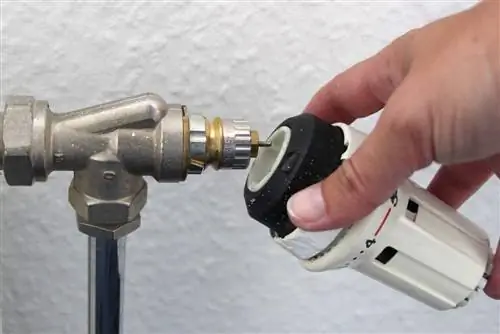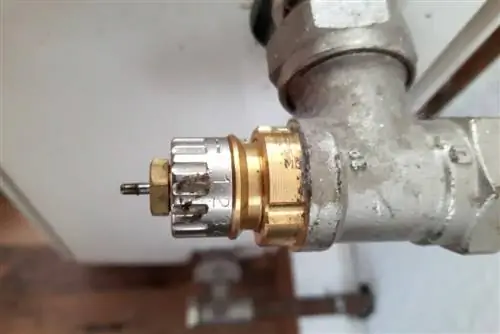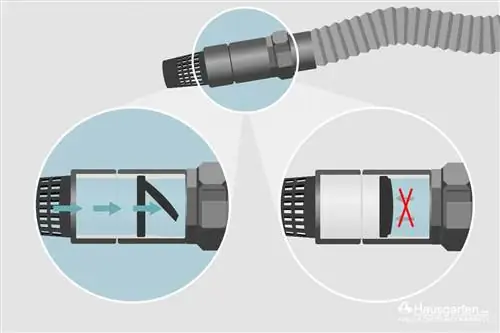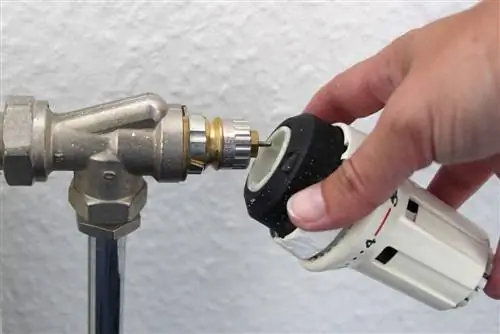- Author admin [email protected].
- Public 2023-12-17 03:39.
- Last modified 2025-01-24 12:45.
There is usually no heating in summer. When the new heating season starts, the radiators may not initially get warm. The reason for this is usually stuck radiator valves
Cause
There is a so-called radiator valve in every radiator in the apartment. It regulates the supply of hot water to the body. However, if this valve is stuck, no water can flow. As a result, the heater stays cold. In order to change this, the stuck heating valve must be loosened or made operable. This is relatively easy and can be done by almost anyone. However, before you get started, you should definitely check whether the heating system as a whole really works. This usually requires going into the boiler room - i.e. into the room where the burner and pump are located. If both are running and the water is heating up, you can safely assume that it is actually the valves that are causing the apartment to not get warm.
Note:
Stuck valves usually occur after the summer break, when, as we know, there is no heating and the valve mechanism is idle for a long time. The problem usually occurs in autumn, when heating is to be started again for the first time.
Find valves
If you want to solve stuck valves in your radiators, you obviously have to find them first. This is also incredibly easy. They are always located directly under the radiator thermostat, i.e. the knob that can be used to regulate the temperature. In order to access the valve directly, the thermostat must be removed. Depending on the type, different measures are necessary. If the head is screwed to the pipe directly at the base, the nut is loosened at this point with pliers and the entire object is unscrewed. If the attachment is done with a screw on the front of the rotary head, this must be loosened and screwed on. As soon as the head has been removed, a small valve pin becomes visible, which should normally protrude about five millimeters from the inside of the valve. If the pin doesn't do this or can be pushed in, then it's stuck and needs to be made usable again.

Note:
The best way to check whether the pen can be moved is to press it with a finger. If it is deep inside the valve, you should try to pull it out carefully with small pliers.
Pen stuck
If the valve pin is stuck and cannot be loosened with pliers, you should use a hammer to help. This is the best way to do it:
- use only a small, very light hammer
- Tap the side of the valve body with the flat surface of the hammer
- Repeat the process several times
- strike in different places
- Always act carefully so as not to damage the valve
The hammer blows loosen the valve pin. If it doesn't jump out of the recess on its own, it can usually be pulled out with pliers - to the extent that it protrudes by around five millimeters. The valve pin should under no circumstances be pulled out completely.
Make it accessible
No matter whether the valve pin has to be pulled out first or whether it sticks out of the valve and cannot be moved - it definitely needs to be made usable again. The aim is to ensure that the small component can be moved easily and without resistance. In most cases you need a lubricant for this. Either fat or oil can be used. Here's how to proceed:
- apply a small amount of grease or oil to the pen
- slide it in carefully
- then pull it out again
- Repeat the process several times
- maybe use small pliers initially
Only when the valve pin no longer hangs and can be easily pushed in and pulled out will the thermostat valve or heating valve be fully functional again. The radiator thermostat can then be put back on. The water supply should now be possible without any problems. In addition, the temperature should be able to be regulated via the thermostat head.
Work carefully
So getting a stuck radiator valve working again is no big deal and doesn't require any special knowledge or experience. The most important tip in this context, however, is that you should always work very carefully and never use brute force. The heater valve is a relatively sensitive mechanical component that can be damaged relatively easily. That's why caution is always advised. The valve pin must under no circumstances be damaged or its shape changed, otherwise the thermostatic valve would no longer work and would have to be replaced. In most cases, a lot of patience is required. So it's important to take your time with this task and not try by hook or by crook to get it to loosen.






